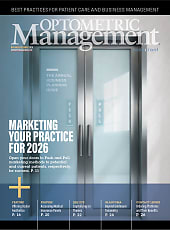PATIENTS FREQUENTLY exclude themselves as contact lens candidates because they have astigmatism. Nearly half of patients (47.4%) meet the threshold of 0.75 D of refractive astigmatism in at least 1 eye to qualify for soft toric contact lens correction (Morgan et al, 2025). Toric soft lenses account for 28% of all soft contact lens fits (Morgan et al, 2025). In a recent report, 17% of glasses-only wearers cited astigmatism as the reason they had never tried contact lenses (Contact Lens Institute, 2024). Misperceptions about astigmatism are widespread and the result is that many patients assume contact lens wear is not an option.

With substantial growth in availability, toric soft lens prescribing has increased from 24.4% of soft daily single-vision lens fits in 2000 to 46.2% in 2023 (Efron et al, 2024). A study showed a toric lens fit success rate of 80% in existing spherical lens wearers, 75% in contact lens dropouts, and 70% in neophytes (Sulley et al, 2013). Improved lens designs and expanded parameter ranges contribute to fit success.
Rather than relying on patients to self-select, practitioners can keep patients current with advances in contact lens technology and aware of what is available and applicable to them. Today’s astigmatic patients stand to benefit from the vision correction provided by toric lenses, particularly with the increased demands of digital device use on the eyes.
A 2025 study looked at the impact of toric soft contact lenses on functional near visual performance with a smartphone (Read et al, 2025). The study population had low to moderate astigmatism of –0.50 D to –1.50 D. Toric contact lenses improved high- and low-contrast near visual acuity and reduced reading errors when compared to the best sphere lenses. A significantly greater focusing demand and narrower palpebral aperture, which are measures associated with digital eye strain, were found with the best sphere lenses. The study supports the clinical use of toric contact lenses to provide optimal vision for digital near tasks, which are ubiquitous in today’s technological world.
Recent innovations make toric prescribing efficient and reliable. Chair time is reduced due to optimized lens geometries that improve rotational stability and decrease orientation recovery time. Clinical data shows that 77% of toric lenses settle within 5° of the ideal location within a minute (Sulley, 2013), and most current soft toric lenses rotationally recover in 2 minutes after application (Momeni-Moghaddam, 2014). This effectively reduces chair time to that of a spherical lens fit for a majority of fits and removes barriers to fitting toric lenses.
Proactively offering toric contact lenses can improve patient satisfaction. Astigmatism should not be an impediment to contact lens wear. The opportunity lies in initiating the toric conversation, rather than waiting for patients to ask.
References
1. Morgan PB, Woods CA, Tranoudis IG, et al. International contact lens prescribing in 2024. Contact Lens Spectrum. 2025 Jan 1;40(1):22-24,26,28-30. clspectrum.com/issues/2025/januaryfebruary/international-contact-lens-prescribing-in-2024/
2. Beyond vision: Behaviors to attract new & returning contact lens wearers. Contact Lens Institute. Spring 2024. Accessed August 1, 2025. contactlensinstitute.org/wp-content/uploads/2024/04/CLI-Beyond-Vision-Report-Spring-2024-FINAL.pdf
3. Efron N, Morgan PB, Woods CA, Jones D, Jones L, Nichols JJ. International trends in prescribing toric soft contact lenses to correct astigmatism (2000-2023): An update. Cont Lens Anterior Eye. 2024 Oct;47(5):102276. doi: 10.1016/j.clae.2024.102276
4. Sulley A, Young G, Lorenz KO, Hunt C. Clinical evaluation of fitting toric soft contact lenses to current non-users. Ophthalmic Physiol Opt. 2013 Mar;33(22):94-103. doi: 10.1111/opo.12028
5. Read SA, Vincent SJ, Colorado LH, Wood JM, Collins MJ. The impact of toric contact lens correction upon functional near visual performance with digital devices. Cont Lens Anterior Eye. 2025 Apr 10;102415. doi: 10.1016/j.clae.2025.102415
6, Momeni-Moghaddam H, Naroo SA, Askarizadeh F, Tahmasebi F. Comparison of fitting stability of the different soft toric contact lenses. Cont Lens Anterior Eye. 2014 Jun 2;37(5):346-350. doi: 10.1016/j.clae.2014.05.003



